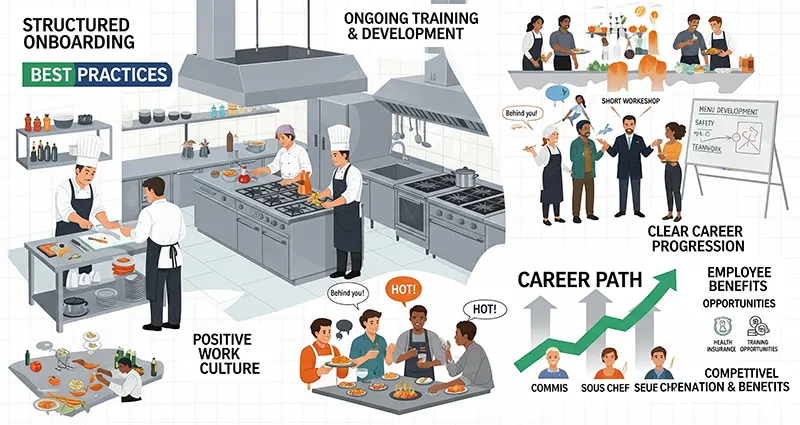The heart of any successful restaurant is its kitchen. It’s a high-pressure environment where a well-oiled team can produce culinary magic, and a disjointed one can lead to chaos and inconsistency. In an industry notorious for high turnover, mastering the art of training and retaining kitchen staff is not just an operational goal—it’s a critical business imperative. By investing in your team, you’re not just creating better cooks; you’re building a culture of excellence, loyalty, and long-term success.
Part 1: Training for Excellence
Effective training goes far beyond a quick tour of the kitchen. It’s about establishing a clear foundation of skills, knowledge, and values from day one.
1. Standardize and Document Everything
Don’t rely on a “shadow and learn” approach. Create a comprehensive training manual that includes:
- Standardized Recipes: Every dish should have a clear, step-by-step recipe with precise measurements.This ensures consistency regardless of who is on the line.
- Safety and Hygiene Protocols: This is non-negotiable. Thoroughly train all staff on food safety regulations, proper knife handling, equipment use, and sanitation procedures. Regular refreshers are crucial to maintain high standards.
- Workflow and Station Management: Clearly define the roles and responsibilities for each station (e.g., sauté, grill, pantry). A well-organized kitchen with a clear workflow is a high-performing kitchen.
2. Implement a Hands-On, Blended Learning Approach
People learn in different ways. A successful training program combines multiple methods to cater to diverse learning styles.
- Mentorship: Pair new hires with experienced, well-respected members of your team. A mentor can provide real-time feedback, answer questions, and make new staff feel like a valued part of the team.
- Visual Aids: Use visuals to reinforce training. Place posters with proper handwashing techniques, temperature charts, or plating diagrams in strategic locations.
- Simulated Service: Before a new employee is thrown into the dinner rush, conduct practice drills or “dry runs.” This builds confidence and teaches them how to manage pressure without the risk of an actual service disaster.
3. Foster a Culture of Continuous Learning
Training shouldn’t end after the first week. The best kitchens are those where staff are always learning and growing.
- Cross-Training: Train staff on multiple stations. This not only makes your team more versatile during peak hours or staff shortages but also gives employees a broader understanding of the kitchen’s operation.
- Skill Workshops: Host regular, short workshops on new culinary techniques, menu item introductions, or even topics like food costing and inventory management.This empowers staff with new skills and demonstrates your investment in their professional development.
- Performance Feedback: Conduct regular performance assessments. Provide constructive, actionable feedback and use it as an opportunity to identify skill gaps and create a personalized development plan.
Part 2: Retaining Your Talent
Once you’ve built a skilled team, the next challenge is keeping them. Retention is about more than just a good paycheck; it’s about creating an environment where people feel valued, respected, and motivated.
1. Create a Positive and Respectful Culture
The kitchen is an inherently stressful place. A leader’s attitude and the overall culture can make or break a team.
- Lead by Example: Stay calm and positive, especially during a rush. A frantic manager creates a frantic team.
- Respect and Recognition: Acknowledge the hard work of every team member, from the dishwasher to the sous chef. A simple “thank you” or a shout-out during a pre-shift meeting can go a long way. Consider an “Employee of the Month” program or small bonuses for exceptional performance.
- Open Communication: Foster an environment where staff feel comfortable providing feedback and raising concerns without fear of reprisal. Conduct regular check-ins to gauge morale and address pain points.
2. Invest in Their Well-Being and Growth
Retention is about demonstrating that you care about your employees as people, not just as workers.
- Fair Compensation and Benefits: While not the only factor, competitive wages and benefits like health insurance or paid time off are essential.They show that you value your team’s contribution and health.
- Career Development: Show your staff that a kitchen job can be a long-term career. Create clear career paths from a line cook to a sous chef or even a head chef.Promote from within whenever possible to prove that hard work and dedication are rewarded.
- Flexible Scheduling: The demanding hours of the restaurant industry are a leading cause of burnout. While not always easy, offering some flexibility in scheduling or avoiding “clopening” shifts (closing late and opening early) can significantly improve morale and reduce turnover.
3. Foster a Sense of Team and Belonging
A strong team feels like a family. Building this camaraderie is key to long-term retention.
- Team-Building Activities: Organize post-shift gatherings, potlucks, or even off-site outings. These activities help staff build relationships outside of the high-pressure environment of the kitchen.
- Staff Meals: Providing a good, hot meal before a shift not only keeps staff fueled but also fosters a communal atmosphere and demonstrates care.
- Empower Your Staff: Give your team a sense of ownership. Ask for their input on new menu items or operational improvements. When staff feel like their ideas are valued, they become more engaged and invested in the restaurant’s success.
By prioritizing both comprehensive training and a supportive, growth-oriented culture, you can transform your kitchen from a revolving door into a stable, high-performing team. In doing so, you’ll not only enhance the quality of your food but also create a business that is more resilient, more profitable, and a better place to work.










